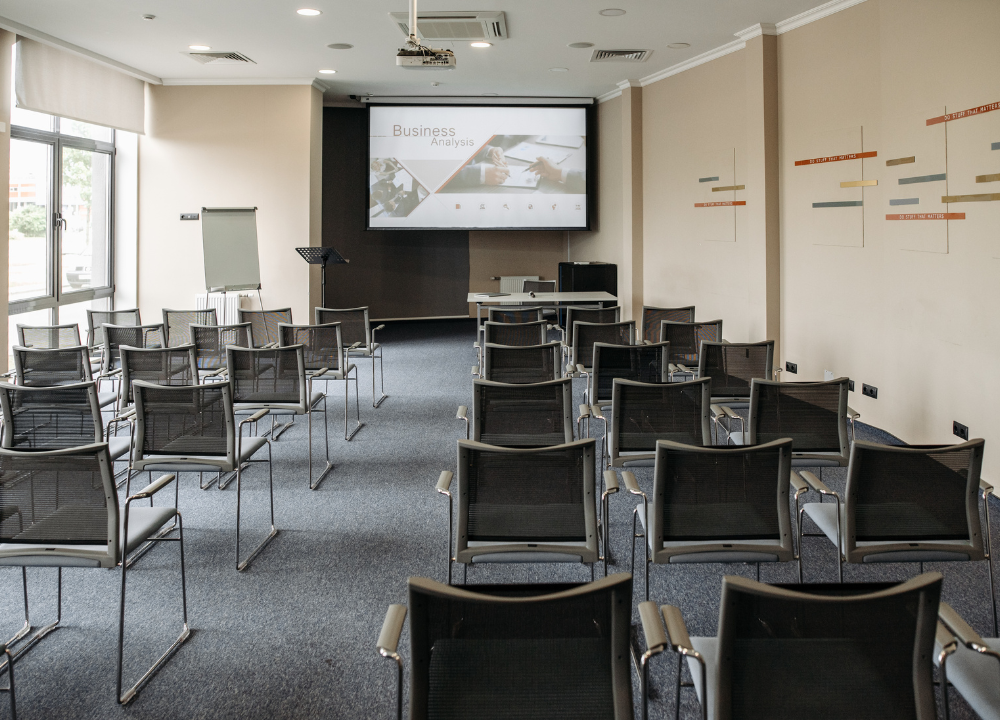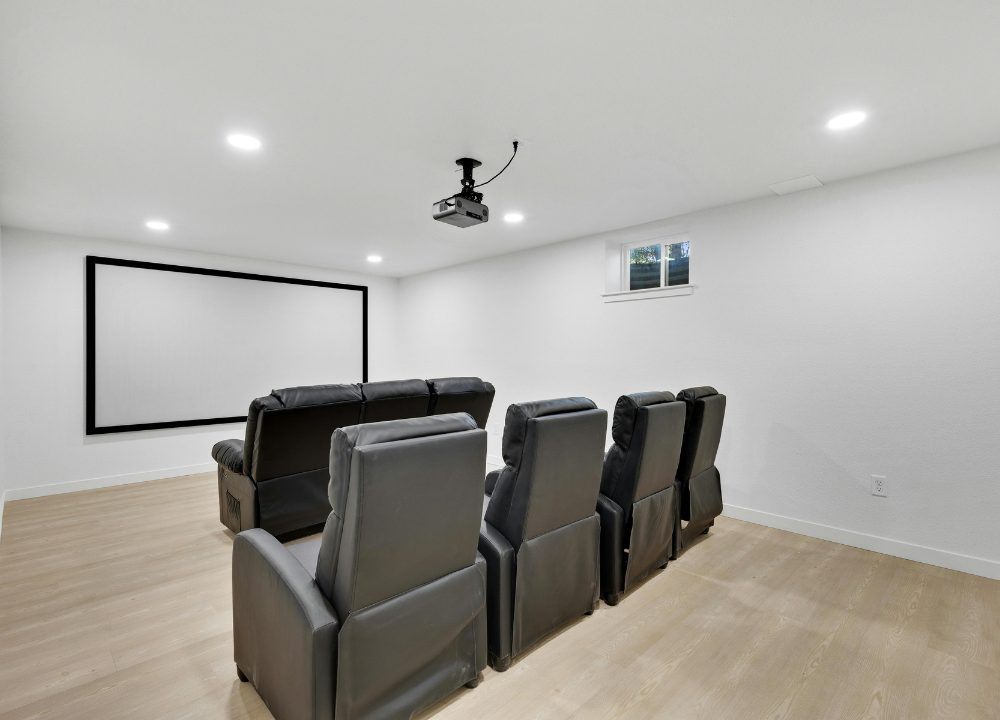- What to Look For: Key Criteria When Choosing a 150-Inch Projector Screen
- Top 150-Inch Projector Screens Options Worth Considering
- Comparative Matrix: Which 150" Screen Fits Your Use Case?
- Practical Installation Tips for a 150 Inch Projector Screen
- Did We Miss Anything?
- Conclusion
- Frequently Asked Questions
A 150-inch projector screen provides breathtaking immersion if you want to achieve true cinematic scale in your home theater. With modern 4K/8K projectors, brighter light engines, and advanced screen materials, 150-inch diagonal screens are no longer just for theaters.
Choosing a screen this size, however, is not easy: ambient light, surface flatness, mounting options, gain, and cost all become important considerations. In 2025, several new materials and motorized systems will make giant screens more reliable and flexible than ever.
In this guide, we’ll:
- Explain the major criteria you need to consider
- Review the top 150-inch screen models and types.
- Compare pros and cons (fixed frame, motorized, ALR, etc.)
- Offer practical installation tips.
- Answer frequently asked questions.
By the end, you’ll understand not just which screens are good, but why they stand out. Let’s get into it.
What to Look For: Key Criteria When Choosing a 150-Inch Projector Screen

Before you choose a model, make sure it meets these requirements. These factors distinguish a good 150-inch projector screen from a bad one.
Screen Type & Form Factor (Fixed, Motorized, Tensioned, Pull-down)
- Fixed Frame/Wall-mount: Always taut and flat, ideal for dedicated theaters, but permanent.
- Motorized/Electric Blinds: Retractable, hidden when not in use, but need reliable motors and tensioning to avoid sagging.
- Tab-Tension / Tensioned Screens: Use side cables to keep the surface flat, which is critical at this size to avoid ripples.
- Pull-down / Floor-rising: Portable but harder to maintain flatness at large sizes.
At 150″, even minor waviness is magnified, so tensioned and motorized systems tend to outperform non-tensioned ones.
Material & Surface Properties (Gain, ALR, CLR, Contrast)
- Matte White / MaxWhite: Standard, wide viewing angles, good for dark rooms.
- High-Gain / Silver: Boosts brightness, but can cause hotspots or narrow viewing angles.
- ALR / CLR / Ambient Light Rejection: Especially useful when your screen faces windows or overhead lights. For example, the Starling Tab-Tension CLR® 5 offers ceiling light rejection to minimize washout. Projector Screen Resource
- Black backing: Blocks light from behind, improving contrast.
- Seams & joints: At this size, you may face multi-panel seams; high-end screens aim to minimize or hide these.
Screen Flatness & Uniformity
Even a slight belly or sag shows up at 150″. High-end tensioning systems and rigid frames help maintain a perfectly flat surface. Tab-tension designs help keep consistent tension across the screen.
Motor/Drive Reliability & Noise
For motorized screens, durable, quiet motors and proper wiring are essential. Cheap motors may hum, stutter, or fail, especially under the stress of a large, heavy surface.
Installation & Mounting Logistics
- Wall strength: The wall or ceiling must support the weight and width of the screen.
- Height: You’ll need enough vertical clearance for the full drop plus extra for gear.
- Access: Ease of access for maintenance, wiring, or repair.
- Alignment: Precise alignment is critical; even slight tilts or offsets get magnified.
Price & Value (Cost per Inch + Warranty)
Because 150″ screens are bulky and expensive, you should evaluate the cost per diagonal inch, the quality of materials, and warranty terms. Also check shipping logistics (some models ship in heavy crates).
Compatibility with Projector Type (Standard Throw, Short Throw, UST)
Ultra-short throw (UST) and laser projectors often require specialized screen materials (CLR / ALR) and surfaces designed to redirect light coming from below rather than a more traditional throw. Vendors like ProjectorScreen.com offer UST/ALR 150″ options. ProjectorScreen.com
Top 150-Inch Projector Screens Options Worth Considering

Below are some standout models and series currently available (or anticipated) in 2025. These reflect a mix of motorized, fixed, and ambient-light-optimized choices.
Note: Availability and pricing can vary by region. Always verify local suppliers, shipping logistics, and warranty coverage.
Elite Screens Spectrum 150″ Motorized
- Type: Electric motorized drop-down
- Material: ISF-certified matte white front projection surface, Amazon
- Highlights: Remote control, quiet motor, easy installation, solid picture quality
- Pros: Balanced and reliable general-purpose screen
- Cons: In bright rooms, not as effective as ALR / CLR surfaces
Starling Tab-Tension CLR® 5 (150″)
- Type: Motorized tab-tension, CLR surface
- Benefit: Rejects overhead light (ceiling lamps, etc.) while preserving brightness and contrast. Projector Screen Resource
- Ideal for: Rooms with ambient overhead lighting where a blackout environment isn’t feasible
- Caveat: CLR surfaces can produce subtle “sparkle” or hotspots in some setups. Calibration and projector matching are critical.
VEVOR / Generic 150″ Fixed or Stand Screens
Often, lower-cost options are listed on Best Buy or other retailers under the “150-inch projector screens” category, including fixed frames or folding screens. Best Buy
- Pros: Affordable entry to large-scale projection
- Cons: Material quality, flatness, and seam visibility may suffer. Better as a backup option.
AWOL Vision ALR C-150 Ultra Short Throw Screen
- Type: Fixed frame ALR / ambient-light-reject screen designed for UST / short-throw projectors. Best Buy
- Strengths: Ideal when using a UST projector; strong ambient light control
- Trade-off: Fixed installation; less flexible if you change room layouts
Screens from ProjectorScreen.com (140–150 inch Class)
ProjectorScreen.com lists dozens of premium 140–150″ screens for various types (fixed, motorized, and ALR).
- Custom options: Many can be ordered with ALR, CLR, tensioned systems, or rigid frames
- Advantage: You can tailor specs (gain, surface, format) to your needs
- Consideration: Higher price and lead times for custom builds
Comparative Matrix: Which 150″ Screen Fits Your Use Case?
Here’s a quick comparison to help you choose based on your specific needs:
| Use Case | Recommended Screen Type / Model | Why It Fits | Potential Drawbacks |
| Dark home theater with minimal ambient light | Elite Spectrum 150″ motorized or high-end matte white fixed | Good balance, cost-effective | May not handle stray light well |
| Living room with ambient overhead lighting | Starling CLR 150″ (tab-tension) | Rejects overhead light, keeps contrast | CLR surfaces can produce spotlighting if misaligned |
| Using an ultra-short-throw (UST) projector | AWOL Vision C-150 ALR or UST-compatible ALR 150″ | Built specifically for UST lighting geometry | Fixed, less flexible for future projector changes |
| Tight budget, occasional use | VEVOR or generic 150″ folding/fixed models | Affordable access to a large size | Lower material or tension quality, seam issues |
| Custom or premium build | Custom 150″ screen from specialized vendors (e.g., ProjectorScreen.com) | Tailored to your room and projector | Cost, lead time, logistics |
Practical Installation Tips for a 150 Inch Projector Screen
Installing a screen this size demands precision and planning. Here are actionable tips:
- Measure twice, mount once
Confirm your wall/ceiling can support the weight. Use strong masonry anchors or studs. - Use a level and shim for perfect alignment.
Even a slight tilt becomes glaringly obvious at full size. - Allow extra margin for motor travel.
Ensure no obstructions above or below the full drop. - Cable and power management
Combine the screen motor, control lines, and possible IR / RF receivers in a tidy conduit. - Pre-stress or tension after mounting
Motorized/tab-tensioned systems often benefit from initial cycles to settle the material. - Lighting control is key.
Use blackout shades, ceiling blackout cloth, or directional lighting to enhance contrast where ALR/CLR aren’t sufficient. - Projector calibration and alignment
A 150″ image magnifies minor lens or keystone errors. Use lens shift, keystone correction sparingly, and fine-tune focus. - Service access
Leave space for removing the case or accessing motor parts if needed.
Did We Miss Anything?
Given the evolving tech and new screen materials emerging in 2025, here are a few bonus pointers:
- Emerging flexible CLR/ALR fabrics: Lightweight CLR fabrics with improved color fidelity are entering the market; watch for them in custom builds.
- Hybrid screen surfaces: Some companies now blend standard matte regions with ALR stripes.
- Warranty & maintenance: At this scale, you’ll want 5+ year warranties and accessible replacement parts.
- Transport/shipping constraints: For many 150″ screens, crate shipping is inevitable. Confirm doorways, stairs, and handling logistics.
Conclusion
Choosing a 150-inch projector screens in 2025 is about balancing scale with quality. The “wow” factor is undeniable, but only when the image is flawless, flat, and well-lit (or well shaded). A mediocre screen will ruin the effect.
If I had to pick a safe all-rounder, the Elite Spectrum 150″ motorized gives you reliable performance, quiet operation, and good image fidelity in controlled environments. But if your room has overhead lighting or wider windows, the Starling Tab-Tension CLR 150″ is a smart upgrade for its ambient light rejection.
If your projector is ultra-short throw or you’re building a dedicated theater, lean toward ALR/CLR surfaces designed for the throw geometry. And for buyers with custom budgets and spaces, working with a specialist vendor on a tailored 150″ screen ensures your setup is optimized from the ground up.
Start by defining your room’s light conditions, projector type, and mounting constraints. Use the matrix above, review sample units, and plan your installation carefully. A 150-inch projector screen can be a showpiece if done right.
Frequently Asked Questions
Q1: Can a regular matte white screen work at 150″ in ambient light?
Yes, in a fully darkened room it can work fine. But when there’s ambient light (ceiling lights, windows), the contrast will suffer. In such cases, ALR or CLR materials are strongly recommended.
Q2: Do 150-inch projector screens always require seams or multiple panels?
Often, yes. Many 150″ models are made from multiple segments or require splicing. High-end brands aim to minimize seam visibility through precise alignment and matching materials.
Q3: What is the ideal projector brightness for a 150″ screen?
As a rule of thumb, a projector with at least 2,500–3,500 ANSI lumens (or equivalent) is recommended for a 150″ image in controlled lighting. For rooms with moderate light, target 4,000+ lumens or more.
Q4: How important is tensioning in large screens?
Extremely important. Without tension (tab-tension systems or rigid framing), the surface may sag, ripple, or wrinkle, especially at 150″. Tensioning keeps the viewing surface perfectly flat.
Q5: Can I retrofit an existing 150” fixed frame with an ALR/CLR surface?
Yes, in many cases, the frame can be reused. You’d need to acquire the ALR/CLR fabric, ensure it fits the frame, and possibly re-tension it. However, verify whether the frame depth, mounting geometry, and design accommodate the new material’s properties.


